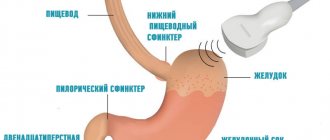Causes of a “lazy stomach”
Functional dyspepsia syndrome is associated with several sources:
- Dietary disorders, expressed in frequent snacking on the go, consumption of dry and “fast” food (fast food), insufficient consumption of liquid foods, including hot liquid foods, excessive consumption of food, large amounts of nutrients in food, especially fat.
- Eating a diet with no or insufficient amounts of minerals and vitamins in food. Such an imbalance of substances in food causes functional deficiency.
- Human age is aggravated by enzymatic deficiency, which is accompanied by longer residence of food products in the digestive organs.
- Neoplasms in the stomach that interfere with the normal digestion of food mass, gastritis, consequences of ulcerative processes and other structural and functional abnormalities.
- Nervous shocks and psycho-emotional stress reduce the secretion of juice in the stomach, which causes low enzymatic activity, resulting in dyspepsia. Impaired production of gastric juice is often a consequence of uncontrolled use of medications.
- Disorders of organs other than the digestive system: systemic renal or liver failure.
Symptoms
Signs of a “lazy” stomach are:
- In the gastric region there are unpleasant sensations with a combination of heaviness, which begin to progress after eating food.
- After a meal, a painful sensation may occur in the gastric area.
- Very fast satiety after eating a small portion of food.
- The feeling of mild nausea may intensify and be accompanied by vomiting.
- Flatulence, gas content in the stomach.
In addition to the above general symptoms of functional dyspepsia, there are other signs depending on its type. There are 4 types of dyspepsia:
- Fermentation form, accompanied by a high level of formation of gaseous substances, moving them along with gastric juice and causing rumbling. A person experiences a frequent urge to defecate.
- The ulcerative form of dyspepsia is characterized by the presence of constant or frequent pain.
- The putrefactive form reveals itself as a decrease in appetite, general malaise, and poor health.
- With the pancreatic form, a person has increased irritability, often defecates with loose stools, has stomach rumbling, and a sharp decrease in appetite.
Treatment
If you identify symptoms of a “lazy” stomach, you should not aggravate the functional failure of the digestive organ. A balanced diet with no overeating, multiple small portions of food help normalize gastric digestion of food. Refusal or restriction of food intake that causes irritation of the gastric mucosa (saltiness, spicy foods, citrus fruits and other acidic foods) quickly restores gastric secretion and peristalsis.
The use of medications should be discussed with a doctor after undergoing diagnostic procedures. You should not make a diagnosis on your own without taking into account your general health condition. The doctor may prescribe medications to improve the secretion of digestive enzymes if enzyme deficiency is detected. Detection of Helicobacter pylori in the stomach requires the selection of antibacterial agents.
Treatment of lazy bowel syndrome
The specific treatment method is determined after accurately determining the causes of the pathology.
If poor patency of any part of the intestine is detected, the problem is eliminated surgically. In other cases, medications to improve peristalsis, folk remedies and therapeutic exercises help cope with the problem of a lazy intestine.
Treatment with medications:
- To stimulate bowel movements, it is recommended to take Glauber's salt. The drug increases osmotic pressure, as a result of which the absorption of fluid by the walls of the organ decreases, and consequently, peristalsis improves. Even with acute constipation, bowel movement occurs 1-2 hours after taking the drug. Frequent use is excluded, as it can cause dehydration;
- A spoonful of castor oil can solve the problem, as taking the product helps the stool move. The laxative effect is achieved after 4-6 hours. There may be slight pain in the abdominal area;
- You can take drugs that enhance motility, such as Vasopressin. However, it is worth remembering that such drugs have strong side effects and are contraindicated in patients with circulatory disorders. Therefore, they should be used exclusively as prescribed by a doctor, who determines the dosage;
- Taking a laxative such as Guttalax stimulates the bowels well. This is a synthetic drug based on sodium picosulfate monohydrate. The laxative effect appears 6-12 hours after administration;
- Senadexin is a natural remedy based on an extract obtained from senna leaves. Tones smooth muscles, which leads to contraction of the walls of the organ and easier bowel movements.
You should not overuse such methods, as the intestines may forget how to work independently. As soon as bowel movements are regulated, you should stop taking medications.
If your baby has a problem, doctors recommend creating a proper diet, giving a tummy massage if constipation occurs, and be sure to accustom the child to feasible physical activity. If constipation occurs as a result of a psychological factor, a calm conversation will help to establish normal bowel function. Drug treatment is usually required if there is vomiting and if there is regular difficulty passing stool.
Prevention
You can prevent the symptoms of “lazy stomach” syndrome by following simple rules of nutrition and lifestyle:
- daily introduce into the diet foods containing a large amount of fiber (cereals, vegetable dishes, fresh fruits and vegetables);
- limit the intake of fatty and difficult-to-digest foods, do not allow the daily dose of fats (especially animals) to exceed 50 mg;
- do not eat heavily before bed, it is advisable not to eat 2 hours before expected sleep;
- Allow your body to cleanse itself of heavy food one day a week. On a fasting day, you can drink mineral water, eat light food (kefir, broth, juices, etc.);
- Drink still mineral water on an empty stomach and maintain plenty of drinking water throughout the day;
- adhere to an optimal motor regimen with evening walks and physical exercises during the day. Mood and physical activity improve the functioning of the digestive organs;
- limit the consumption of alcoholic beverages, stop smoking;
- learn how to quickly and optimally get out of stressful situations that are a stupor for normal digestion.
A “lazy stomach” will stop frequently giving out whims if you follow the above set of recommendations.
Diet
Every year, people increasingly began to think about how to make their stomach work. Many people do not even suspect that the health of the digestive system depends on what and how we eat. If you still don’t eat right, but want to start leading a healthy lifestyle, you need to act without fanaticism. To begin with, gradually reduce your portions and chew your food more thoroughly.
Solid, heavy foods are much less digestible, so a “lazy stomach” will never want to start working. Be sure to follow the regime. Eat at the same time every time. Half an hour before meals, drink a glass of water. This procedure will make your digestive system work smoothly.
Eat the most high-calorie foods for breakfast and lunch. For dinner, doctors recommend only light, low-calorie foods.
Don't forget about fasting days. This does not mean that you will have to starve. Do not do this under any circumstances. Eat only light foods. For example, fruits, vegetables, kefir and fermented baked milk. This way your stomach will take a break from heavy food and take up its work with renewed vigor.
Concept of a lazy stomach
A lazy stomach occurs in both adults and children of different ages. This pathological process is usually understood as insufficient functionality of the gastric cavity. In medicine, this disease is called functional dyspepsia. During the study, no deviations were detected. All blood, urine and stool parameters are within normal limits.
But at the same time, the person complains of a feeling of heaviness in the stomach, flatulence and nausea. When you eat a small amount of food, you feel full.
The main function of this organ is the enzymatic grinding of products, rhythmic mixing of the food mass, and peristaltic contractions. The gastric cavity becomes lazy if there is insufficient implementation of all of the above actions.
Exercises for lazy bowels
One of the first places to eliminate discomfort is physical activity. Even basic movements will help move the intestines and stabilize the gastrointestinal tract. Today there is a special program, the implementation of which will help cope with this problem.
Let's look at a few simple exercises that you can do yourself:
- Starting position (IP) - standing, arms extended forward and performing 5 squats. The back should be straight. Similar lazy bowel exercises can be used for children;
- IP lying on your back. The surface must be smooth and hard. Tighten your abdominal muscles and lift your body up. They freeze in this position for a few seconds and return to IP. It is recommended to repeat up to 5 times;
- IP as in the previous exercise. Take a deep breath and hold your breath for 5 minutes. After the time has passed, exhale slowly. Repeat 10 times;
- IP lying down, legs and arms apart. The knees are pulled to the chest and taken with the hands and try to touch the forehead with them. They remain in this position for a few seconds and return to the IP;
- IP on knees and elbows. They focus on their hands and take turns raising their legs up. Repeat movements at least 7 times.
Causes of a lazy stomach
Lazy stomach syndrome occurs for various reasons such as:
- poor nutrition with snacks on the go, the use of fast foods and processed foods, insufficient fluid intake, high fat and carbohydrate content;
- long-term adherence to a diet lacking mineral components and vitamins in foods;
- age indicators with aggravated enzyme deficiency;
- formation of neoplasms in the gastric cavity. Tumors prevent food from being fully digested;
- frequent nervous shocks, mental disorders or prolonged depression.
The cause of the pathology is diseases of the internal organs of a chronic nature, kidney or liver failure.
It is generally accepted that a sluggish stomach is more common in children aged 9 to 13 years and students. But older people over 60 years old also face this problem.
Features of a lazy stomach in children
In childhood, functional dyspepsia develops quite often; this fact is explained by the imperfection of the digestive and enzyme systems in this age category. In young children with a lazy stomach, not only the functioning of this organ is usually disrupted, but also the intestines, biliary system and other organs.
According to the observations of specialists, periodic pain and discomfort in the abdomen is observed in approximately 20% of school-age children. A comprehensive examination of such patients does not reveal any organic pathology of the gastrointestinal tract.
Symptomatic picture
In the absence of timely treatment, a functional disorder can lead to serious pathologies.
Many patients simply ignore the signs, citing self-recovery of the body. If you have a lazy stomach, the symptoms are characterized by:
- nausea and vomiting;
- quick satiation even with small amounts of food;
- a feeling of fullness and heaviness in the epigastric region;
- discomfort in the solar plexus area after a meal;
- flatulence;
- rumbling in the stomach;
- an increase in the number of bowel movements. Diarrhea may occur;
- loss of strength, weakness, chronic fatigue;
- painful sensations in the abdomen;
- heartburn and belching with sour contents.
In addition, the clinical picture depends on the type of pathology.
In medicine there are:
- fermentation form. If a lazy stomach is detected, the symptoms will be accompanied by increased formation of gases and rumbling. The patient also often complains of a frequent urge to defecate;
- ulcerative form. This type of syndrome leads to constant and frequent pain in the gastric cavity;
- putrefactive form. Manifested by decreased appetite, general malaise, poor health;
- pancreatic form. As a result of the development of such an illness, a person becomes more irritable. He often suffers from diarrhea. In addition to all this, the patient complains of rumbling in the stomach and loss of appetite.
Only an experienced doctor can determine the type of pathological process based on the symptoms of the disease.
Diagnostic measures
If the stomach does not want to function fully, then you need to urgently seek help from a doctor. The doctor will ask about any complaints, conduct an external examination, and then prescribe an examination.
- donating blood for general and biochemical analysis;
- delivery of urine and feces to detect impurities and bacterial agents;
- conducting an X-ray examination using a contrast agent;
- performing ultrasound diagnostics of the abdominal organs;
- carrying out manometry and scintigraphy.
Fibro- and phagogastroscopy is considered one of the mandatory types of diagnostics. Such techniques allow you to fully examine the organ from the inside. To identify the cause of a functional disorder, gastric juice is examined. This will help determine the acidity level and take the right measures.
Therapeutic measures
Treatment of a lazy stomach involves complex therapy. It includes:
- taking medications;
- use of traditional methods;
- diet;
- change in lifestyle.
Complex therapy gives more results and allows you to eliminate any cause of the pathological process.
Drug therapy
Drugs are prescribed by a doctor after performing diagnostic measures. When the cause of the pathology is Helicobacter pylori infection, the doctor prescribes antibacterial agents. Often, the regimen includes two medications at once - Amoxicillin and Clarithromycin. They must be taken at the same time.
How to make a lazy stomach work
Treatment of functional dyspepsia necessarily includes a set of measures. First of all, you need to give up bad habits, adjust your daily routine (alternating work and rest), and follow the food restrictions prescribed by your doctor. In addition, pharmacotherapy, traditional and alternative medicine are indicated.
What drugs are used to treat a lazy stomach:
- sedatives to normalize the psyche;
- histamine receptor blockers;
- proton pump inhibitors;
- prokinetics (peristalsis).
When gastritis is detected, eradication therapy is prescribed.
In order to enhance the impact on the causes of the pathological condition, many doctors advise taking a course of physiotherapy procedures aimed at strengthening the immune system and normalizing the functioning of the digestive system. The following are popular: electroanalgesia, aromatic baths, acupuncture. The main thing is to make sure there are no contraindications.
Traditional medicine shows good results. After the gastroenterologist's approval, you can drink an infusion of flax seeds, tea from chamomile, mint, lemon balm, a pharmaceutical collection of St. John's wort and calendula. In addition, raisins, prunes, dried apricots, and dried apples are useful for activating metabolism.
General recommendations for the treatment of dyspepsia:
- Avoid clothing and accessories that constrict your body.
- To prevent bile stagnation, sleep on a high pillow.
- Avoid any foods that cause heartburn or flatulence.
- Take more walks in the fresh air.
- Try not to overload your body.
The prognosis for treatment is usually favorable. By following the advice of doctors, you can normalize your condition in a relatively short period of time.
Preventive actions
A lazy stomach is considered one of the common problems. To avoid the development of such a process, you need to follow some recommendations.
- There are foods high in fiber: baked apples and pears, cereals, stewed vegetables.
- Do not overeat, especially before going to bed.
- Give your body a rest once a week. You need to stop eating heavy foods. On a fasting day, it is better to drink mineral water without gases, kefir, and chicken broth.
- Physical training helps a lot. Every morning before breakfast you need to do special exercises.
- Give up bad habits such as smoking and drinking alcohol.
- Avoid stressful situations. Yoga, water aerobics, and swimming will help you get out of depression.
- Drink fermented milk products at night. This will improve digestion and the state of microflora.
A sluggish stomach leads to fermentation and putrefactive processes. This leads to gradual intoxication of the body and deterioration of the general condition. You should not let the disease progress, but consult a doctor when the first signs appear.
A “lazy stomach,” the symptoms and treatment of which we will consider in this article, is a set of digestive tract disorders that arise due to impaired motility of the stomach. In medicine, this disease is called dyspepsia. The pathology is characterized by pain and discomfort in the upper gastrointestinal tract, rapid satiety, nausea and bloating.
How to treat
Many people think about how to make their stomach work. Sometimes it’s enough just to adjust your diet, and stomach problems will disappear. However, to solve the problem completely, you need to analyze your lifestyle. Don't forget to exercise. Indigestion is increasingly being noticed among office workers who sit for most of the day. Many people, as soon as they notice the symptoms of a “lazy stomach,” immediately go to the pharmacy to buy pills. However, most often medications are not enough, because the problem may not be solved with pills. In this case, other treatment methods must be used.
Reasons for the development of the disease
Lazy stomach syndrome is considered a functional disorder due to the fact that the digestive organ does not perform the necessary functions. Currently, medical specialists cannot say unambiguously what causes the disease. But many attending physicians agree that nervous stress affects the functioning of the gastrointestinal tract. Nervous experiences can provoke disturbances in the functioning of the stomach and intestines. That is why experienced gastroenterologists, along with medications intended to restore the functioning of the gastrointestinal tract, prescribe sedatives.
Exercises to improve peristalsis
There are very simple, but at the same time quite effective exercises that will quite fully answer the question of how to make the stomach work at home and improve intestinal function. They are performed in the morning, without getting out of bed.
After waking up, you need to lie on your stomach and, turning your body, reach with your right hand towards the ceiling. You need to do at least 10 repetitions.- After completing the first exercise, you need to lie on your back and cross your arms over your chest. Trying not to lift your legs off the bed, you lift and lower your body. After completing five repetitions, a lying position is assumed, while the arms remain crossed. By bending your legs at the knee joint, your legs are pulled towards your chest. The number of repetitions is the same.
- The next exercise is borrowed from yoga and is called “Cobra”. Before performing it, for greater effectiveness, it is recommended to drink 200-400 ml of hot or warm water. After this, the position of lying on your stomach is assumed and in this case it is better to lie on the floor. When pushing off the floor with your hands, you need to straighten your arms as much as possible, while keeping your pelvis pressed to the floor. At the extreme point, you should linger for a few seconds, and then return to the starting position.
- Starting position: standing. The hands are on the shoulders, the elbows are directed forward. Trying not to move your arms, you need to reach the opposite elbow with your knees. The number of repetitions is 10 on each leg.
Abdominal massage complex
Another set of exercises will eliminate the need to take any laxatives, while restoring bowel function. It includes seven simple massage techniques. First of all, before performing a massage, you need to take three deep breaths so that the diaphragm gently massages the intestines.
The breathing technique should be as follows: first, the stomach is inflated, after which the chest is turned on, then a slight hold and exhale. At the end of exhalation, you need to draw in your stomach as much as possible.
In part, such breathing will already start the work of the gastrointestinal tract. After breathing comes the main massage complex.
- Here the main task will be to stimulate the center of the abdomen in the navel area. The thumb is placed in this area and lightly pressed with the second hand so that the finger sinks slightly into the stomach. Then circular movements are performed clockwise. These movements should be performed at a slow rhythm, without releasing pressure on the finger. This will allow you to massage the internal organs from the inside. You need to repeat the movement seven times.
- This massage is identical to the first one, only you need to use not the thumb, but the surface of the entire fist. The movement should also occur clockwise, affecting the entire surface of the abdomen. The number of repetitions is the same.
- Local effect on the large intestine. The movement begins from the groin area, from the right side. With the palm of your right hand, you need to press on this area and hold for three seconds, then slowly shift the center of pressure to the middle of the abdomen for seven seconds. After this, you can move on to the ascending region of the large intestine, which is located midway between the right hypochondrium and the groin region. The movement technique is the same.
- Next you need to massage the transverse colon, which tends to sag. It is located between the xiphoid process and the navel. The abdomen is completely relaxed, the fingers of the right hand slowly sink into this area and no longer move to the side, but upward. In the same way, the left hypochondrium and the descending colon, which is located symmetrically to the ascending colon, are massaged.
- After performing the previous massage, stroking the abdomen begins again clockwise with the surface of the entire fist.
- Stimulation of points that regulate intestinal function. They are located at the junction of the arms and the body, that is, in the tendons of the axillary part and the pectoralis major muscle. These points are grabbed on each side with your fingers and lightly pressed seven times.
- To harmonize the whole body after the massage, at the end of the complex the following yoga movement is performed, which consists of shaking the abdomen. To do this, it is better to stand up, while resting your hands on your knees. Then, as you exhale, light movements are made with the abdominal muscles.
Pubis muscle training
A very good exercise would also be to train the pubococcygeus muscle. It is located between the coccyx and the pubis in humans. The fact is that the human intestines practically lie on it. It also contains the urethra and vas deferens. However, this muscle is not trained in any way and is often inactive even when working out in the gym. The essence of the entire exercise will be to alternately tense and relax this muscle. This can also be practiced while urinating. This action must be repeated at least 50 times.
The good thing about this exercise is that it can be performed in any conditions - sitting at work, in front of the TV, or even on the subway. Due to the fact that the intestines are located next to this muscle, it will also be affected. Most likely, after a couple of days, you will notice an improvement in bowel function. In addition to dynamic training of this muscle, you can also practice static tension, that is, do a short delay during tension.
Intestinal motility disorders are a very unpleasant phenomenon. A person with this condition cannot do anything normally - neither work nor fully relax. All this happens due to the fact that he has the so-called lazy stomach syndrome.
What to do in these cases and what to do, each person, as a rule, decides for himself: some take pills and medications, while others resort to treatment with folk remedies.
Sometimes such disorders are accompanied by flatulence, and in other cases abdominal pain or constipation appears. One way or another, you can get rid of intestinal atony by performing simple exercises, self-massage and eating certain foods, in particular those with a laxative effect.
Symptoms of the disease
Immediately after eating, the patient shows the first signs of dyspepsia. In the upper part of the digestive tract, a person begins to experience unpleasant, painful sensations. Some patients note that after a meal they feel fullness and bloating in the stomach, heartburn, nausea and even vomiting occur.
If the symptoms described above appear frequently, and laboratory tests have not shown the presence of other problems with the gastrointestinal tract, then it is necessary to force the “lazy stomach” to function at full capacity. If functional disorders are not treated, the pathological process can develop into a chronic form of the disease.
In addition to those listed, the “lazy stomach” syndrome may have the following symptoms: flatulence, frequent urge to go to the toilet, constant rumbling in the stomach. These symptoms are characteristic of fermentative dyspepsia.
If putrefactive dyspepsia develops in the body, the patient begins to complain of poor health and appetite worsens.
With an ulcer-like “lazy stomach,” the patient complains of severe abdominal pain.
If pancreatic dyspepsia occurs, the following symptoms appear: diarrhea, loss of appetite, nervousness.
Causes of the disease
How to make your stomach work? This is not an easy task. But it is even more difficult to find out what causes such an unpleasant illness. The most common is poor nutrition. And gastroenterologists confirm this information. First, you will notice how your stomach begins to “growl”, after which nausea and pain in the abdominal area appear.
If you overeat very often, eat a lot of fatty foods, and also have diseases of the oral cavity and teeth, then do not be surprised at the appearance of negative symptoms. Very often, indigestion occurs after eating a large amount of sweets.
Diagnosis of pathology
A gastroenterologist can make a diagnosis based on a medical examination. Using electrogastrography, the doctor determines functional disorders in the stomach. Using this technique, electrical signals are determined that cause contractions in the stomach and some parts of the intestines. Dyspepsia is characterized by a decrease in electrical activity after eating (with normal values - on an empty stomach).
Additional examinations may also be required: urine and feces analysis, examination of gastric juice for the presence of Helicobacter and acid levels, blood biochemistry, ultrasound of the abdominal organs, etc.
Diagnostics
Lazy gut is a symptom, not a diagnosable disease. Therefore, a person who experiences slow digestion should see a doctor for a diagnosis.
Traditional remedies for constipation, such as eating more fiber or drinking more water, may not help with slow digestion. It is important that the doctor obtain detailed and accurate information about the person's symptoms and medical history. This will help make an accurate diagnosis.
The doctor may do a physical exam to check for abnormalities in the rectum and anus. Some doctors can evaluate the condition of the pelvic floor muscles. Doctors may also use diagnostic tests and procedures, such as colonoscopy, to detect any abnormalities in the digestive tract.
Treatment of the disease
Lazy stomach syndrome requires complex treatment. The patient is advised to eat often, but in small portions. With this method of eating, food is digested more easily and does not linger in the digestive organ. It is necessary to minimize the consumption of food that irritates the gastric mucosa (spicy and smoked foods, spices and marinades).
Drug treatment can only be prescribed by a gastroenterologist after a diagnostic examination. What to do if the disease is caused by the presence of Helicobacter pylori in the body? The patient is prescribed antimicrobial and antibacterial therapy. In addition, the doctor prescribes medications that affect gastric motility and peristalsis. Antacids and painkillers may be prescribed.
Traditional methods of treatment
Medicines that have anti-inflammatory properties and also coat the stomach can help cope with the disease. To prepare folk remedies that help with dyspepsia, dried fruits, pharmaceutical plants, seeds, etc. are used.
Flaxseeds can make your stomach work. To prepare a medicinal infusion, you need to pour 20 grams of flax seeds into a glass of water (chilled) and leave to infuse overnight. After 12 hours, add grated carrots, raisins and honey to the liquid. The resulting medicinal porridge must be eaten 2 times a day before meals.
Important! Treatment with folk remedies for a “lazy stomach” can only be started after consultation with your doctor. Herbs and plants contain active components that can be harmful, so self-medication can cause severe consequences.
Dried fruits (prunes, dates, raisins and dried apples) have a beneficial effect on the functioning of the stomach. To prepare the medicine, you need to pour boiling water over the dried fruits, steam them, and then grind them into a fine paste. Then add honey there. Drink the mixture on an empty stomach in the morning, and also before going to bed.
A decoction of chamomile, St. John's wort, mint or sage helps to activate the gastrointestinal tract. To prepare a decoction, add 10 grams of dried herb flowers to a glass of boiling water and leave for 30 minutes. Drink instead of tea.
Traditional methods
To activate the stomach, you can use a collection of dried fruits.
Treatment of a lazy stomach with folk remedies can only be carried out after consultation with a doctor. Plants contain a lot of active components, so self-medication can be dangerous. Traditional healers recommend making medicines that coat the stomach and have anti-inflammatory effects. Medicinal plants, dried fruits, seeds, etc. can be used. Treatment of infants with folk remedies is strictly prohibited due to the high probability of developing an acute allergic reaction.
Dried fruits
To activate a lazy organ, folk remedies use a collection of dried fruits. Dried apples, raisins, dates, prunes, dried apricots, and figs are suitable for its preparation. You will need 100 g of each component. The ingredients are washed and poured with boiling water for a few minutes (they should steam). After this, you need to grind the dried fruits (it is convenient to do this with a meat grinder). It should be a paste. Next, you need to add 100 g of honey, nuts, flaxseeds and mix all the ingredients thoroughly. It is recommended to take the medicine in the morning on an empty stomach 30 minutes before meals and before going to bed (5 g each).
Flax seeds
Flaxseeds can help your stomach work. An infusion must be prepared from them. To do this, pour 20 g of seeds into 200 g of chilled boiled water overnight. In the morning you need to add raisins (pre-rinse and pour over boiling water), grated carrots and 20 g of honey. The ingredients should be mixed well. It is recommended to take the medicine twice a day on an empty stomach. Flax seeds can be used in another recipe. 20 g of seeds are poured on the floor with a glass of chilled boiled water overnight. In the morning you need to pour in 20 g of honey, yogurt, and fruit juice. You need to take 100 g of the medicine in the morning on an empty stomach.
Chamomile and other plants
If you are sick, it is useful to drink chamomile tea.
Chamomile can be brewed instead of tea. To do this, 10 g of dried flowers are steamed with 200 g of boiled water and allowed to stand for half an hour. After this, the tea needs to be strained and drunk. You can add chamomile to regular green tea. It is useful to use mint, St. John's wort, and sage in this way. The medicine must be taken warm to enhance the effect. It is permissible to mix chamomile with calendula and St. John's wort. To do this, you will need up to 10 g of plants, which are steamed with boiling water (200 g) for half an hour. You need to drink the infusion 4 times a day.










